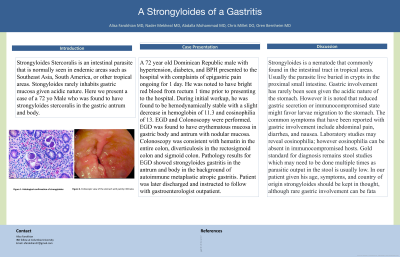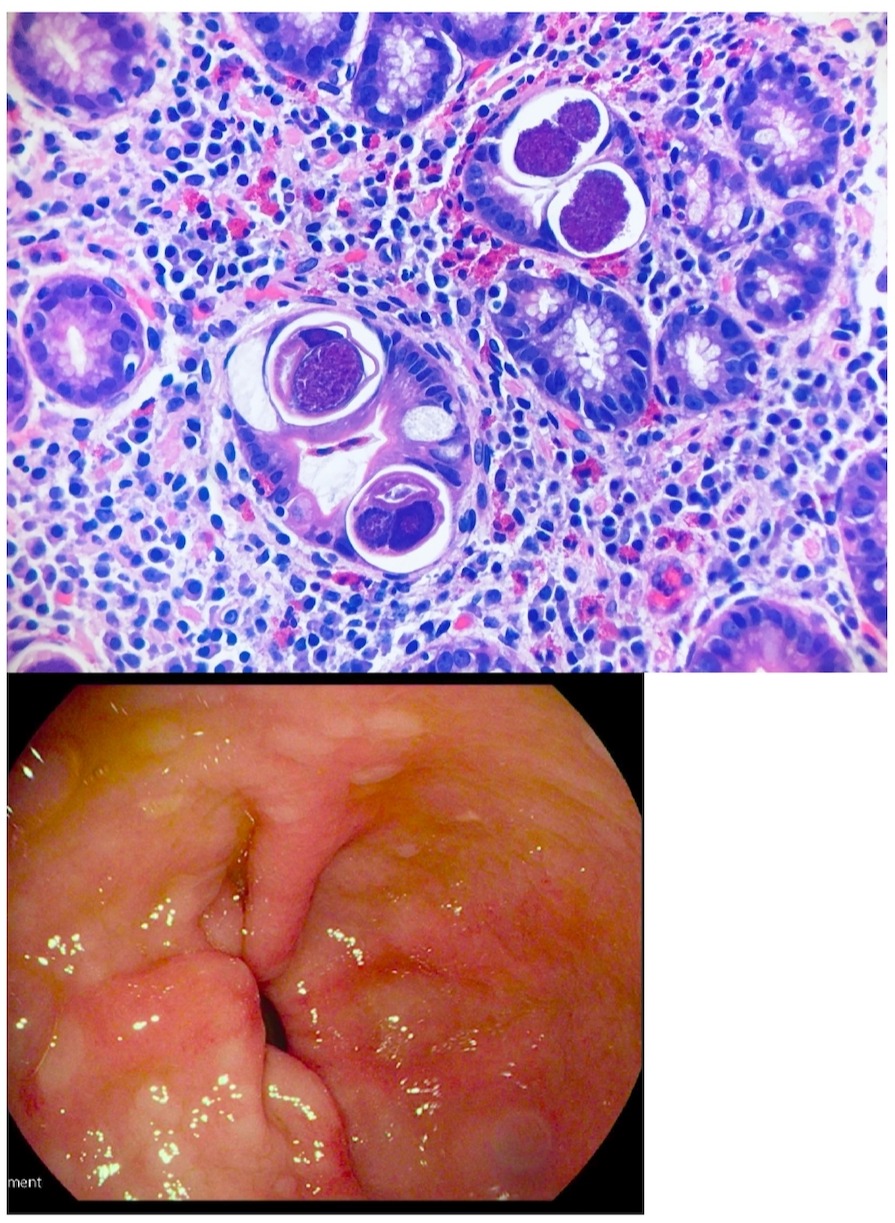Back


Poster Session B - Monday Morning
Category: Stomach
B0723 - A Strongyloides of a Gastritis
Monday, October 24, 2022
10:00 AM – 12:00 PM ET
Location: Crown Ballroom

Has Audio
- AF
Alisa Farokhian, MD
St. Joseph's University Medical Center
Paterson, NJ
Presenting Author(s)
Alisa Farokhian, MD1, Nader Mekheal, MD2, Chris Millet, DO3, Abdalla Mohamed, MD4, Oren Bernheim, MD5
1St. Joseph's University Medical Center, Paterson, NJ; 2St. Joseph's University Center, Paterson, NJ; 3Penn Medicine, Paterson, NJ; 4Saint Joseph's University Medical Center, Paterson, NJ; 5St. Joseph's Regional Medical Center, Paterson, NJ
Introduction: Strongyloides Stercoralis is an intestinal parasite that is normally seen in endemic areas such as Southeast Asia, South America, or other tropical areas. Stongyloides rarely inhabits gastric mucosa given acidic nature. Here we present a case of a 72 yo Male who was found to have strongyloides stercoralis in the gastric antrum and body.
Case Description/Methods: A 72 year old Dominican Republic male with hypertension, diabetes, and BPH presented to the hospital with complaints of epigastric pain ongoing for 1 day. He was noted to have bright red blood from rectum 1 time prior to presenting to the hospital. During initial workup, he was found to be hemodynamically stable with a slight decrease in hemoglobin of 11.3 and eosinophilia of 13. EGD and Colonoscopy were performed. EGD was found to have erythematous mucosa in gastric body and antrum with nodular mucosa. Colonoscopy was consistent with hematin in the entire colon, diverticulosis in the rectosigmoid colon and sigmoid colon. Pathology results for EGD showed strongyloides gastritis in the antrum and body in the background of autoimmune metaplastic atropic gastritis. Patient was later discharged and instructed to follow with gastroenterologist outpatient.
Discussion: Strongyloides is a nematode that commonly found in the intestinal tract in tropical areas. Usually the parasite live buried in crypts in the proximal small intestine. Gastric involvement has rarely been seen given the acidic nature of the stomach. However it is noted that reduced gastric secretion or immunocompromised state might favor larvae migration to the stomach. The common symptoms that have been reported with gastric involvement include abdominal pain, diarrhea, and nausea. Laboratory studies may reveal eosinophilia; however eosinophilia can be absent in immunocompromised hosts. Gold standard for diagnosis remains stool studies which may need to be done multiple times as parasitic output in the stool is usually low. In our patient given his age, symptoms, and country of origin strongyloides should be kept in thought, although rare gastric involvement can be fatal.

Disclosures:
Alisa Farokhian, MD1, Nader Mekheal, MD2, Chris Millet, DO3, Abdalla Mohamed, MD4, Oren Bernheim, MD5. B0723 - A Strongyloides of a Gastritis, ACG 2022 Annual Scientific Meeting Abstracts. Charlotte, NC: American College of Gastroenterology.
1St. Joseph's University Medical Center, Paterson, NJ; 2St. Joseph's University Center, Paterson, NJ; 3Penn Medicine, Paterson, NJ; 4Saint Joseph's University Medical Center, Paterson, NJ; 5St. Joseph's Regional Medical Center, Paterson, NJ
Introduction: Strongyloides Stercoralis is an intestinal parasite that is normally seen in endemic areas such as Southeast Asia, South America, or other tropical areas. Stongyloides rarely inhabits gastric mucosa given acidic nature. Here we present a case of a 72 yo Male who was found to have strongyloides stercoralis in the gastric antrum and body.
Case Description/Methods: A 72 year old Dominican Republic male with hypertension, diabetes, and BPH presented to the hospital with complaints of epigastric pain ongoing for 1 day. He was noted to have bright red blood from rectum 1 time prior to presenting to the hospital. During initial workup, he was found to be hemodynamically stable with a slight decrease in hemoglobin of 11.3 and eosinophilia of 13. EGD and Colonoscopy were performed. EGD was found to have erythematous mucosa in gastric body and antrum with nodular mucosa. Colonoscopy was consistent with hematin in the entire colon, diverticulosis in the rectosigmoid colon and sigmoid colon. Pathology results for EGD showed strongyloides gastritis in the antrum and body in the background of autoimmune metaplastic atropic gastritis. Patient was later discharged and instructed to follow with gastroenterologist outpatient.
Discussion: Strongyloides is a nematode that commonly found in the intestinal tract in tropical areas. Usually the parasite live buried in crypts in the proximal small intestine. Gastric involvement has rarely been seen given the acidic nature of the stomach. However it is noted that reduced gastric secretion or immunocompromised state might favor larvae migration to the stomach. The common symptoms that have been reported with gastric involvement include abdominal pain, diarrhea, and nausea. Laboratory studies may reveal eosinophilia; however eosinophilia can be absent in immunocompromised hosts. Gold standard for diagnosis remains stool studies which may need to be done multiple times as parasitic output in the stool is usually low. In our patient given his age, symptoms, and country of origin strongyloides should be kept in thought, although rare gastric involvement can be fatal.

Figure: Figure a. Histologic image of strongyloides in the gastric mucosa surrounded by eosinophils
Figure b. Showing Endoscopic view of strongyloides gastritis
Figure b. Showing Endoscopic view of strongyloides gastritis
Disclosures:
Alisa Farokhian indicated no relevant financial relationships.
Nader Mekheal indicated no relevant financial relationships.
Chris Millet indicated no relevant financial relationships.
Abdalla Mohamed indicated no relevant financial relationships.
Oren Bernheim indicated no relevant financial relationships.
Alisa Farokhian, MD1, Nader Mekheal, MD2, Chris Millet, DO3, Abdalla Mohamed, MD4, Oren Bernheim, MD5. B0723 - A Strongyloides of a Gastritis, ACG 2022 Annual Scientific Meeting Abstracts. Charlotte, NC: American College of Gastroenterology.
